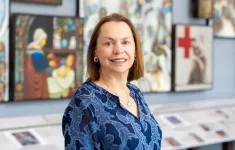(Press-News.org) What if your earbuds could do everything your smartphone can do already, except better? What sounds a bit like science fiction may actually not be so far off. A new class of synthetic materials could herald the next revolution of wireless technologies, enabling devices to be smaller, require less signal strength and use less power.
The key to these advances lies in what experts call phononics, which is similar to photonics. Both take advantage of similar physical laws and offer new ways to advance technology. While photonics takes advantage of photons – or light – phononics does the same with phonons, which are the physical particles that transmit mechanical vibrations through a material, akin to sound, but at frequencies much too high to hear.
In a paper published in Nature Materials, researchers at the University of Arizona Wyant College of Optical Sciences and Sandia National Laboratories report clearing a major milestone toward real-world applications based on phononics. By combining highly specialized semiconductor materials and piezoelectric materials not typically used together, the researchers were able to generate giant nonlinear interactions between phonons. Together with previous innovations demonstrating amplifiers for phonons using the same materials, this opens up the possibility of making wireless devices such as smartphones or other data transmitters smaller, more efficient and more powerful.
"Most people would probably be surprised to hear that there are something like 30 filters inside their cell phone whose sole job it is to transform radio waves into sound waves and back," said the study's senior author, Matt Eichenfield, who holds a joint appointment at the UArizona College of Optical Sciences and Sandia National Laboratories in Albuquerque, New Mexico.
Part of what are known as front-end processors, these piezoelectric filters, made on special microchips, are necessary to convert sound and electronic waves multiple times each time a smartphone receives or sends data, he said. Because these can't be made out of the same materials, such as silicon, as the other critically important chips in the front-end processor, the physical size of your device is much bigger than it needs to be, and along the way, there are losses from going back and forth between radio waves and sound waves that add up and degrade the performance, Eichenfield said.
"Normally, phonons behave in a completely linear fashion, meaning they don't interact with each other," he said. "It's a bit like shining one laser pointer beam through another; they just go through each other."
Nonlinear phononics refers to what happens in special materials when the phonons can and do interact with each other, Eichenfield said. In the paper, the researchers demonstrated what he calls "giant phononic nonlinearities." The synthetic materials produced by the research team caused the phonons to interact with each other much more strongly than in any conventional material.
"In the laser pointer analogy, this would be like changing the frequency of the photons in the first laser pointer when you turn on the second," he said. "As a result, you'd see the beam from the first one changing color."
With the new phononics materials, the researchers demonstrated that one beam of phonons can, in fact, change the frequency of another beam. What's more, they showed that phonons can be manipulated in ways that could only be realized with transistor-based electronics – until now.
The group has been working toward the goal of making all of the components needed for radio frequency signal processors using acoustic wave technologies instead of transistor-based electronics on a single chip, in a way that's compatible with standard microprocessor manufacturing, and the latest publication proves that it can be done. Previously, the researchers succeeded in making acoustic components including amplifiers, switches and others. With the acoustic mixers described in the latest publication, they have added the last piece of the puzzle.
"Now, you can point to every component in a diagram of a radiofrequency front-end processor and say, 'Yeah, I can make all of these on one chip with acoustic waves,'" Eichenfield said. "We're ready to move on to making the whole shebang in the acoustic domain."
Having all the components needed to make a radio frequency front end on a single chip could shrink devices such as cell phones and other wireless communication gadgets by as much as a factor of a 100, according to Eichenfield.
The team accomplished its proof of principle by combining highly specialized materials into microelectronics-sized devices through which they sent acoustic waves. Specifically, they took a silicon wafer with a thin layer of lithium niobate – a synthetic material used extensively in piezoelectronic devices and cell phones – and added an ultra-thin layer (fewer than 100 atoms thick) of a semiconductor containing indium gallium arsenide.
"When we combined these materials in just the right way, we were able to experimentally access a new regime of phononic nonlinearity," said Sandia engineer Lisa Hackett, the lead author on the paper. "This means we have a path forward to inventing high-performance tech for sending and receiving radio waves that's smaller than has ever been possible."
In this setup, acoustic waves moving through the system behave in nonlinear ways when they travel through the materials. This effect can be used to change frequencies and encode information. A staple of photonics, nonlinear effects have long been used to make things like invisible laser light into visible laser pointers, but taking advantage of nonlinear effects in phononics has been hindered by limitations in technology and materials. For example, while lithium niobate is one of the most nonlinear phononic materials known, its usefulness for technical applications is hindered by the fact that those nonlinearities are very weak when used on its own.
By adding the indium-gallium arsenide semiconductor, Eichenfield's group created an environment in which the acoustic waves traveling through the material influence the distribution of electrical charges in the indium gallium arsenide semiconductor film, causing the acoustic waves to mix in specific ways that can be controlled, opening up the system to various applications.
"The effective nonlinearity you can generate with these materials is hundreds or even thousands of times larger than was possible before, which is crazy," Eichenfield said. "If you could do the same for nonlinear optics, you would revolutionize the field."
With physical size being one of the fundamental limitations of current, state-of-the-art radiofrequency processing hardware, the new technology could open the door to electronic devices that are even more capable than their current counterparts, according to the authors. Communication devices that take virtually no space, have better signal coverage and longer battery life, are on the horizon.
END
Good vibrations: New tech may lead to smaller, more powerful wireless devices
What if your earbuds could do everything your smartphone can, but better? A new class of synthetic materials could allow for smaller devices that use less power.
2024-05-09
ELSE PRESS RELEASES FROM THIS DATE:
Revolutionizing nurse work environment research
2024-05-09
PHILADELPHIA (May 9, 2024) – New research from Penn Nursing’s Center for Health Outcomes and Policy Research (CHOPR) – recently published online in the journal Research in Nursing & Health – has successfully validated a new, streamlined version of the Practice Environment Scale of the Nursing Work Index (PES-NWI), originally authored in 2002 by Eileen T. Lake, PhD, RN, FAAN, Professor of Nursing, the Edith Clemmer Steinbright Professor in Gerontology, and Associate Director of CHOPR, who is also lead author on this publication. This innovative tool, known as the PES-5, is designed to revolutionize how nurse work environments are measured across ...
New ‘forever chemical’ cleanup strategy discovered
2024-05-09
As the U.S. Environmental Protection Agency cracks down on insidious “forever chemical” pollution in the environment, military and commercial aviation officials are seeking ways to clean up such pollution from decades of use of fire suppressant foams at military air bases and commercial airports.
Fire-suppression foams contain hundreds unhealthful forever chemicals, known by chemists as PFAS or poly- and per-fluoroalkyl substances. These compounds have stubbornly strong fluorine-to-carbon bonds, which allow them to persist indefinitely in the environment, hence the moniker “forever chemicals.” ...
Squeezed by neighbors, planet glows with molten lava
2024-05-09
UC Riverside astrophysicist Stephen Kane had to double check his calculations. He wasn’t sure the planet he was studying could be as extreme as it seemed.
Kane never expected to learn that a planet in this faraway star system is covered with so many active volcanoes that seen from a distance it would take on a fiery, glowing-red hue.
“It was one of those discovery moments that you think, ‘wow, it’s amazing this can actually exist,” Kane said. A paper detailing the discovery has been published in The Astronomical Journal.
Launched in 2018, NASA’s Transiting Exoplanet Survey ...
GPS-like system shows promise as HIV vaccine strategy to elicit critical antibodies
2024-05-09
DURHAM, N.C. – A team led by the Duke Human Vaccine Institute (DHVI) has developed a vaccine approach that works like a GPS, guiding the immune system through the specific steps to make broadly neutralizing antibodies against HIV.
Publishing in the journal Cell Host & Microbe, the study describes an approach that provides step-by-step directions for the immune system to generate the elusive, yet necessary antibodies for a successful HIV vaccine.
“HIV is the fastest-evolving virus known. So it’s been a long-standing goal in HIV research to create ...
NSF awards $630,000 to study teeth of non-human primates
2024-05-09
The National Science Foundation awarded $630,444 to Kathleen Paul, an assistant professor of anthropology at the U of A, to provide a comprehensive outline of dental genetic architecture for two primate species of tamarins and macaques.
Paul's research team’s ultimate goal is to harness this information to advance bioanthropological practice, including the use of teeth for reconstructing evolutionary processes and experiences of stress and illness.
No live animals will be used in the research. Instead, skeletonized individuals from collections ...
Discrimination may accelerate aging
2024-05-09
Discrimination may speed up the biological processes of aging, according to a new study led by researchers at the NYU School of Global Public Health.
The research links interpersonal discrimination to changes at the molecular level, revealing a potential root cause of disparities in aging-related illness and death.
“Experiencing discrimination appears to hasten the process of aging, which may be contributing to disease and early mortality and fueling health disparities,” said Adolfo Cuevas, assistant professor in the Department of Social and Behavioral Sciences at NYU’s ...
New machine learning algorithm promises advances in computing
2024-05-09
COLUMBUS, Ohio – Systems controlled by next-generation computing algorithms could give rise to better and more efficient machine learning products, a new study suggests.
Using machine learning tools to create a digital twin, or a virtual copy, of an electronic circuit that exhibits chaotic behavior, researchers found that they were successful at predicting how it would behave and using that information to control it.
Many everyday devices, like thermostats and cruise control, utilize linear controllers – which use ...
How climate change will affect malaria transmission
2024-05-09
University of Leeds news release
Embargoed until 1900 BST, 9 May 2024
How climate change will affect malaria transmission
A new model for predicting the effects of climate change on malaria transmission in Africa could lead to more targeted interventions to control the disease according to a new study.
Previous methods have used rainfall totals to indicate the presence of surface water suitable for breeding mosquitoes, but the research led by the University of Leeds used several climatic and hydrological models to include real-world processes of evaporation, infiltration and flow through rivers.
This ...
Presenting a safer, low-cost, and low-energy whole-body magnetic resonance imaging device
2024-05-09
Machine learning enables cheaper and safer low-power magnetic resonance imaging (MRI) without sacrificing accuracy, according to a new study. According to the authors, these advances pave the way for affordable, patient-centric, and deep learning-powered ultra-low-field (ULF) MRI scanners, addressing unmet clinical needs in diverse healthcare settings worldwide. Magnetic Resonance Imaging (MRI) has revolutionized healthcare, offering noninvasive and radiation-free imaging. It holds immense promise for advancing medical diagnoses through artificial intelligence. However, despite its five decades of development, MRI remains largely inaccessible, particularly ...
Climate models predict larger than expected decline in African malaria transmission areas
2024-05-09
Areas at risk for malaria transmission in Africa may decline more than previously expected because of climate change in the 21st century, suggests an ensemble of environmental and hydrologic models. The combined models predicted that the total area of suitable malaria transmission will start to decline in Africa after 2025 through 2100, including in West Africa and as far east as South Sudan. The new study’s approach captures hydrologic features that are typically missed with standard predictive models of malaria transmission, offering a more nuanced view that could inform malaria control efforts in a warming world. Most of the burden of malaria falls on people living ...
LAST 30 PRESS RELEASES:
Statins significantly reduce mortality risk for adults with diabetes, regardless of cardiovascular risk
Brain immune cells may drive more damage in females than males with Alzheimer’s
Evidence-based recommendations empower clinicians to manage epilepsy in pregnancy
Fungus turns bark beetles’ defenses against them
There are new antivirals being tested for herpesviruses. Scientists now know how they work
CDI scientist, colleagues author review of global burden of fungus Candida auris
How does stroke influence speech comprehension?
B cells transiently unlock their plasticity, risking lymphoma development
Advanced AI dodel predicts spoken language outcomes in deaf children after cochlear implants
Multimodal imaging-based cerebral blood flow prediction model development in simulated microgravity
Accelerated streaming subgraph matching framework is faster, more robust, and scalable
Gestational diabetes rose every year in the US since 2016
OHSU researchers find breast cancer drug boosts leukemia treatment
Fear and medical misinformation regarding risk of progression or recurrence among patients with breast cancer
Glucagonlike peptide-1 receptor agonists and asthma risk in adolescents with obesity
Reviving dormant immunity: Millimeter waves reprogram the immunosuppressive microenvironment to potentiate immunotherapy without obvious side effects
Safety decision-making for autonomous vehicles integrating passenger physiological states by fNIRS
Fires could emit more air pollution than previously estimated
A new way to map how cells choose their fate
Numbers in our sights affect how we perceive space
SIMJ announces global collaborative book project in commemoration of its 75th anniversary
Air pollution exposure and birth weight
Obstructive sleep apnea risk and mental health conditions among older adults
How talking slows eye movements behind the wheel
The Ceramic Society of Japan’s Oxoate Ceramics Research Association launches new international book project
Heart-brain connection: international study reveals the role of the vagus nerve in keeping the heart young
Researchers identify Rb1 as a predictive biomarker for a new therapeutic strategy in some breast cancers
Survey reveals ethical gaps slowing AI adoption in pediatric surgery
Stimulant ADHD medications work differently than thought
AI overestimates how smart people are, according to HSE economists
[Press-News.org] Good vibrations: New tech may lead to smaller, more powerful wireless devicesWhat if your earbuds could do everything your smartphone can, but better? A new class of synthetic materials could allow for smaller devices that use less power.





